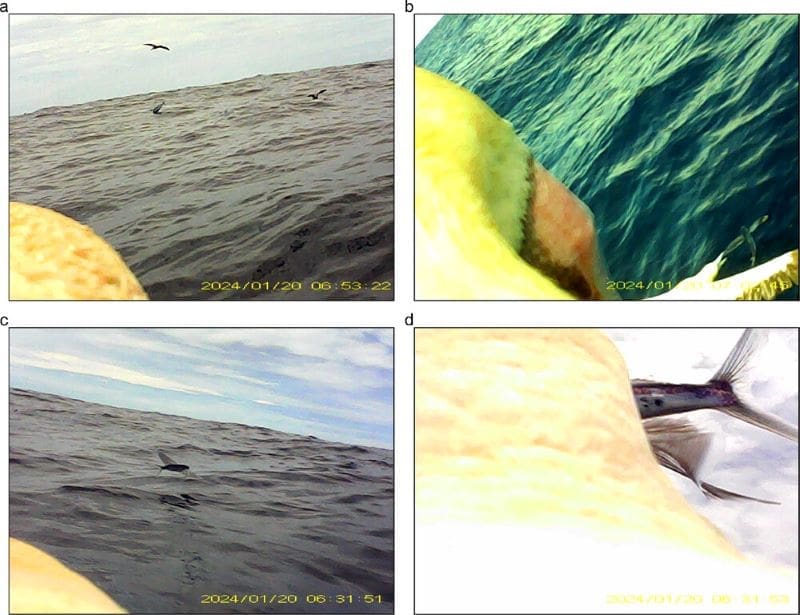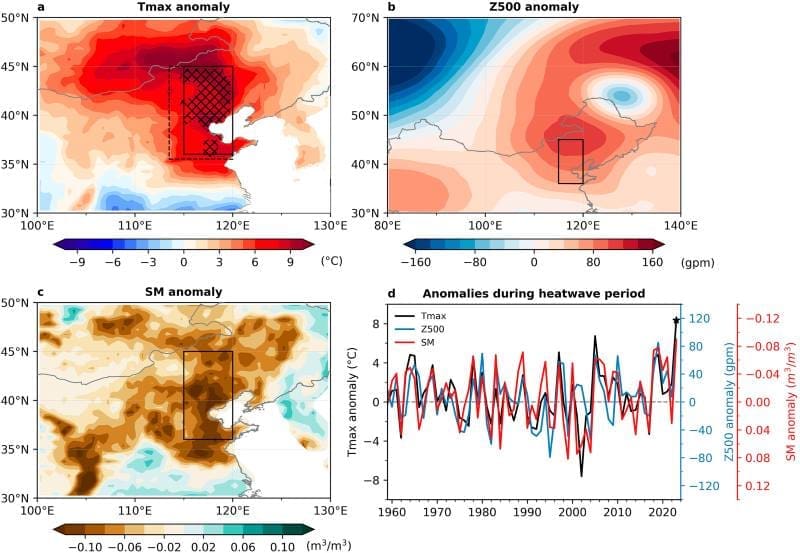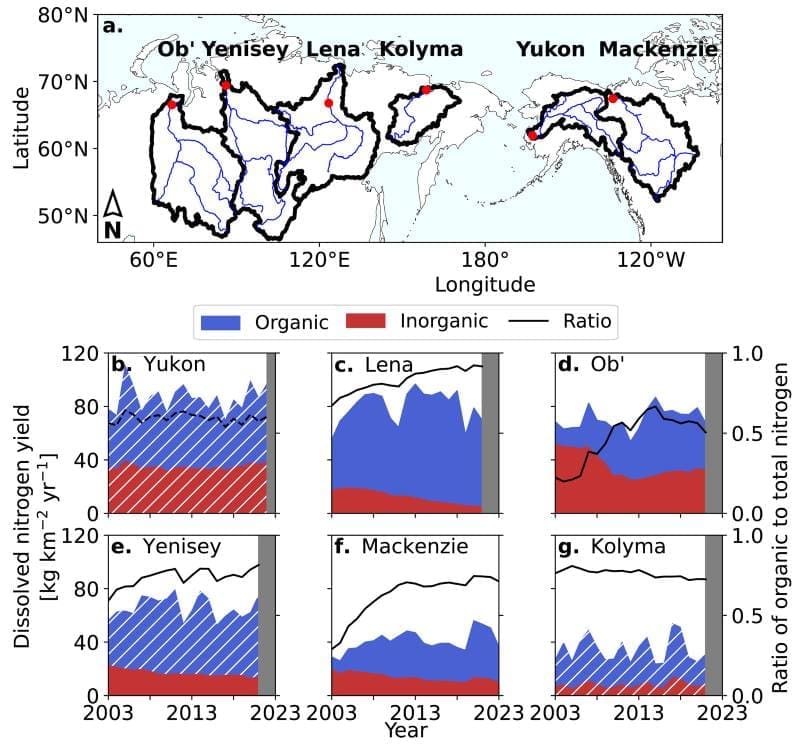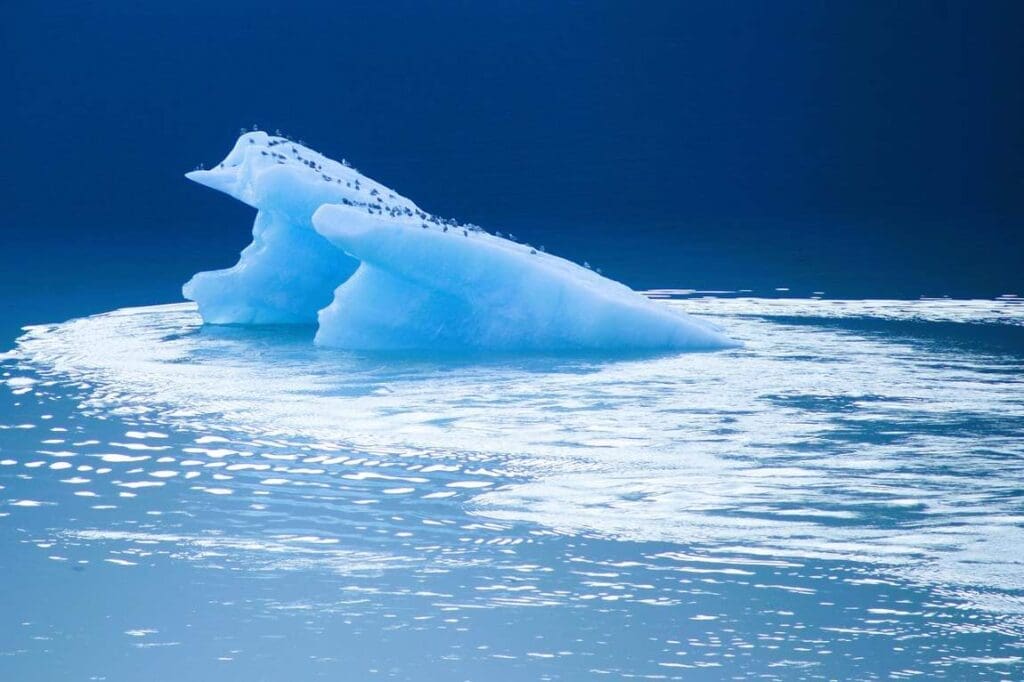Explore the latest insights from top science journals in the Muser Press daily roundup (August 7, 2025), featuring impactful research on climate change challenges.
In brief:
On-board camera footage offers bird’s eye glimpse into seabird flights and feeding behaviour
The footage, obtained by lightweight bird-borne cameras formed part of a study of the lives of seabirds in the waters around the remote archipelago they call home.
Two red-footed boobies – a tropical cousin of the more familiar gannet – were carefully fitted with the tiny cameras to record how they catch their favourite food: flying fish. Of 15 capture attempts, 14 were towards flying fish while in flight and one was an underwater dive.
This is the first such on-board footage revealing that flying fish are caught on the wing. The findings are outlined in the paper ‘Commuting in crosswinds and foraging in fast winds: the foraging ecology of a flying fish specialist’ which is published in Proceedings of the Royal Society B: Biological Sciences.
“The cameras recorded footage of the birds catching flying fish just above the surface of the water, while on the wing,” said Dr Ruth Dunn, a Visiting Researcher at Lancaster University and lead author of the study. “We suspected this happened, but this is the first time that we’ve had bird-borne footage like this showing them foraging and catching fish mid-air. It could suggest they are catching a significant portion of their diet in this way.”
In addition, the research team used small GPS and accelerator tracking devices on 18 more red-footed boobies in the remote Indian Ocean archipelago to show how they use the wind to travel hundreds of kilometres over the deep blue open ocean to hunt fish.

Red-footed boobies have long narrow wings relative to their bodies enabling them to glide quickly and efficiently in high crosswinds. The study showed they prefer tailwinds and crosswinds, especially on their outward journeys towards their feeding areas.
Red-footed boobies hunt in the open ocean and do not stick to specific feeding sites because their prey can be patchy and moves around. The researchers show the birds’ selection of favourable winds allows them to conserve energy while travelling and searching for food.
By selecting favourable winds, the birds reached higher speeds without needing to increase flapping. The researchers believe that the birds may have adapted this behaviour to the unpredictable, patchy food options available to them.
The trackers showed that the birds were more likely to continue to hunt in windier conditions and less likely to rest. This is possibly because when it is windier the flying fish stay in the air for longer which provides better opportunities for the birds to catch them.
“We found that the birds foraged in windy conditions and we think that this might be because flying fish are able to glide in the air for longer in these conditions, making them more accessible to the boobies,” said Dr Dunn.

Understanding how the behaviour of birds, and other flying species, are influenced by winds is of growing importance at a time when global airflow patterns and intensities are shifting due to climate change.
The red-footed booby findings contrast to those by other researchers studying some albatross species, which find it harder to catch prey in windier conditions.
The researchers believe their findings will help provide a clearer picture of how red-footed boobies will fare in a changing world.
“This is the first step in helping us to understand more about how wind influences the behaviour and distribution of tropical seabirds,” said co-author Professor Stephen Votier, from The Lyell Centre, Heriot-Watt University’s global institute for Earth and marine sciences. “By gaining a clearer understanding of such environmental effects will enable us to predict how they will cope in the future.”
The study, which was supported by the Bertarelli Foundation, involved researchers from Lancaster University, Heriot-Watt University, the University of Exeter, and ZSL.
Journal Reference:
Dunn Ruth E., Trevail Alice M., Nicoll Malcolm A. C., Freeman Robin, Braman Charles A., Clark Bethany L., Mitchell Charlotte, Schiffmiller Abigail W., Wood Hannah and Votier Stephen C., ‘Commuting in crosswinds and foraging in fast winds: the foraging ecology of a flying fish specialist’ Proceedings of the Royal Society B: Biological Sciences 292, 2052: 20250774 (2025). DOI: 10.1098/rspb.2025.0774
Article Source:
Press Release/Material by Lancaster University
Unprecedented heat in North China: how soil moisture amplified 2023’s record heatwave
This summer, much of North China has endured widespread temperatures above 35°C. Even typically cooler, high-latitude summer retreats like Harbin in Northeast China – usually a refuge from the heat – saw temperatures soar past 35°C in late June and July. As climate change accelerates, extreme heat events will become increasingly frequent.
Just two years earlier, in late June 2023, North China sweltered under a searing three-day heatwave that arrived weeks earlier than usual and broke six decades temperature records. Daily highs soared past 40°C in some areas, triggering heat-related illnesses, straining the region’s power grid, and threatening crops at the growing season. For millions living in this vital agricultural and industrial heartland, the scorching conditions were a stark reminder of the mounting risks posed by climate extremes.

A new study published in Earth’s Future by researchers Kexin Gui and Tianjun Zhou of the Institute of Atmospheric Physics, Chinese Academy of Sciences, has pointed the dual drivers behind this unprecedented heat: large-scale atmospheric circulation and an unusually strong soil moisture feedback. Using advanced climate analysis techniques, the team found that while an anomalous high-pressure system accounted for nearly 70% of the heatwave’s intensity, the early-season drought and dry soils added another 40% – amplifying the heatwave’s severity far beyond what would have occurred otherwise.
“Dry soils, caused by the lowest rainfall in over four decades, acted like a giant amplifier,” explained lead author Kexin Gui. “With little moisture left to evaporate, the land surface heated up rapidly, pushing temperatures to extremes rarely seen in North China’s early summer.”
The study warns that such conditions may become more common under climate change. Model projections suggest that heatwaves with the same intensity as the 2023 event could become the new normal by the end of the century. While the influence of soil moisture feedback on extreme heat may weaken in the long term due to projected increases in soil moisture.
“Heatwaves of this magnitude put enormous pressure on energy systems, agriculture, and public health,” said Dr. Zhou. “Understanding how soil moisture and atmospheric processes interact is crucial for better predicting and mitigating future extreme weather events.”
The findings underscore the urgency of climate adaptation strategies in North China, where the increasing heat extremes poses a significant threat to livelihoods and ecosystems.
Journal Reference:
Gui, K., & Zhou, T., ‘Soil moisture feedback amplified the earlier onset of the record-breaking three-day consecutive heatwave in 2023 in North China’, Earth’s Future 13, 7: e2024EF005561 (2025). DOI: 10.1029/2024EF005561
Article Source:
Press Release/Material by Institute of Atmospheric Physics (IAP) | Chinese Academy of Sciences (CAS)
Climate change is altering nitrogen composition in Arctic rivers, study finds
Climate change is starving the Arctic Ocean of essential nutrients, with the region’s six largest rivers now delivering far less of the type of nitrogen that marine ecosystems need to survive, according to new research in one of Earth’s most vulnerable regions.
The study, led by Bridger J. Ruyle of NYU Tandon School of Engineering, is published in Global Biogeochemical Cycles, where it has been selected as an Editor’s Choice. Ruyle completed the research as a Postdoctoral Fellow at the Carnegie Institution for Science.
The study found that warming temperatures and thawing permafrost are fundamentally altering the chemistry of Arctic rivers. The result is that coastal food webs that have sustained Indigenous communities for millennia are being deprived of inorganic nitrogen, an essential nutrient, potentially triggering cascading effects throughout the Arctic Ocean ecosystem.
“This is a red flag for the Arctic,” said Ruyle, who joined NYU Tandon in the summer of 2025 as an Assistant Professor in the Civil and Urban Engineering Department. “Rapid changes in river nitrogen chemistry could completely transform how these marine ecosystems function.”

The research analyzed 20 years of data from six major Arctic rivers – the Yenisey, Lena, Ob’, Mackenzie, Yukon, and Kolyma – which collectively drain two-thirds of the land area flowing into the Arctic Ocean. These rivers transport nitrogen that supports up to 66% of the ecosystem’s primary production in coastal Arctic regions.
Between 2003 and 2023, Ruyle and colleagues documented declines in inorganic nitrogen accompanied by simultaneous increases in dissolved organic nitrogen, a far less bioavailable form of the element, in four of the six rivers. The findings reveal that warmer temperatures and increased precipitation caused by climate change are driving the shift in nitrogen composition through their effects on river discharge and permafrost thaw.
Using sophisticated statistical modeling, the researchers identified permafrost loss as the key factor explaining the diverging trends between organic and inorganic nitrogen in these rivers. The study combined 20 years of water chemistry data with environmental variables including temperature, precipitation, land cover, and permafrost extent to pinpoint the climate drivers behind the chemical shifts.
This Arctic rivers research represents Ruyle’s broader research mission to understand how human activity, climate change, and natural processes interact to affect water quality globally. Among other areas of focus, his work includes tracking ‘forever chemicals’ and pharmaceuticals in wastewater.
“Whether we’re looking at PFAS contamination in drinking water or nitrogen cycling in Arctic rivers, the common thread is understanding how environmental changes propagate through water systems,” Ruyle explained. His research explores how human activity, the biosphere, and climate change affect water quality, with particular focus on developing analytical tools to quantify chemical contamination and developing models using remote sensing data to assess climate impacts.
The Arctic findings have implications for ecosystem management and climate adaptation strategies. River transport of nitrogen is estimated to support up to 66% of primary production in Arctic coastal regions, making these compositional changes important for marine food webs and the Indigenous communities that depend on these resources.
The research also highlights the interconnected nature of global environmental challenges. As Ruyle noted in previous work on pharmaceutical contamination, climate-driven water scarcity could exacerbate water quality problems, as there’s less dilution of contaminants during drought conditions. The Arctic study similarly shows how temperature and precipitation changes cascade through complex biogeochemical systems, resulting in water quality and ecosystem impacts
“This work demonstrates why we need to think about water quality and climate change as fundamentally linked challenges,” Ruyle said. ” As climate change intensifies, we must understand these interconnections to protect both human health and ecosystem integrity.”
Along with Ruyle, the paper’s authors are Julian Merder of the University of Canterbury, New Zealand; Robert G.M. Spencer of Florida State University; James W. McClelland of the Marine Biological Laboratory, Woods Hole; Suzanne E. Tank of the University of Alberta; and Anna M. Michalak of Carnegie Institution for Science.
***
The study was supported by the National Science Foundation through grants for the Arctic Great Rivers Observatory.
Journal Reference:
Ruyle, B. J., Merder, J., Spencer, R. G. M., McClelland, J. W., Tank, S. E., & Michalak, A. M., ‘Changes in the composition of nitrogen yields in large Arctic rivers linked to temperature and precipitation’, Global Biogeochemical Cycles 39, 7: e2025GB008639 (2025). DOI: 10.1029/2025GB008639
Article Source:
Press Release/Material by NYU Tandon School of Engineering
Global hunt for ‘positive tipping points’
A tipping point is a threshold where a small change can trigger a significant, often irreversible, transformation.
With climate change becoming increasingly damaging and dangerous, positive tipping points in human societies and economies can spark rapid reductions in emissions and other environmental harm.
Positive tipping points are already happening – with solar power and electric vehicles rapidly displacing fossil-fuelled alternatives – but many more are needed to ensure a thriving, sustainable future.
“The global economy is decarbonising at least five times too slowly to meet the Paris Agreement target of limiting global warming to well below 2°C,” said Professor Tim Lenton, from the Global Systems Institute at the University of Exeter.
“The challenge now is to identify potential positive tipping points, and the actions that can bring them forward – while avoiding wishful thinking about their existence, or oversimplification of their nature, drivers and impacts.”
The paper – by an international team of researchers and published in the journal Sustainability Science – sets out a methodology for identifying positive tipping points, assessing their proximity, identifying the factors that can influence them, and the actions that can trigger them.

This includes looking for evidence that a system, or a similar system, has “tipped” in the past.
Another factor is whether there is potential for “self-propelling uptake” of zero- or low-carbon behaviours, products and/or technologies.
For example, as more people buy electric cars, the performance, price and infrastructure improve – making it easier for others to follow, and thereby accelerating the transition.
“We know positive tipping can happen in sectors such as power and road transport, and we think the UK is close to a tipping point in the uptake of heat pumps,” said Dr Steve Smith, also from Exeter’s Global Systems Institute.
“In other sectors there is little sign of approaching tipping points and in a few, such as nuclear power and concrete production, we should not expect there to be tipping points at all.”
Dr Smith highlighted the potential for beneficial change that may seem unlikely before it happens – such as the banning of smoking in public places in the UK.
“Other transformations – such as a major shift away from meat consumption – might also be more likely than they appear,” he said.
“With supportive policies, meat-free options becoming cheaper and better, and social influence (behaviour spreading through the population), we could see a major impact on meat consumption – and potentially a tipping point with benefits for climate and health.”
The team’s methodology aims to establish a common framework for finding positive tipping points – and they invite fellow researchers to help refine it, and practitioners to apply it.
Professor Frank Geels, from the Manchester Institute of Innovation Research at the University of Manchester, added: “The increased understanding of positive tipping points and improved methods for investigating them are important because they provide empirically validated templates for accelerated net-zero transitions. These offer crucial antidotes to the doom and gloom that seems to permeate climate mitigation debates in policy and mass media.”
Journal Reference:
Lenton, T.M., Powell, T.W.R., Smith, S.R. et al., ‘A method to identify positive tipping points to accelerate low-carbon transitions and actions to trigger them’, Sustainability Science (2025). DOI: 10.1007/s11625-025-01704-9
Article Source:
Press Release/Material by Alex Morrison | University of Exeter
New study links 2023 Maui wildfire to spike in suicide, overdose
The study, led by Alex Ortega, dean of the Thompson School of Social Work and Public Health, and Keawe‘aimoku Kaholokula, chair of the Department of Native Hawaiian Health, in the John A. Burns School of Medicine, both at the University of Hawaiʻi at Mānoa, along with Jonathan Purtle, associate professor at New York University’s School of Global Public Health, is one of the first to show that wildfires can lead to immediate deaths from suicide and drug overdose.
“Nationally and globally, we have seen an increase in devastating wildfires, and these fires can have a tremendous impact on the health and well-being of communities,” said Ortega. “Public health must be adequately prepared to respond to serious mental health consequences of wildfires and other climate-related disasters that are increasing in both frequency and severity.”
Death rates increased statewide
The researchers analyzed death records from all of Hawai‘i’s counties from 2014 through 2023, focusing on suicides and drug overdoses. They compared the death rates before, during and after the wildfires.
The study showed that in August 2023, suicide and overdose death rates increased by 46% statewide. However, the impact was much greater in Maui, where there was a 97% increase in suicide and overdose deaths compared to prior months. When limiting their analysis to just suicides in August 2023, they found that the suicide rate was 182% higher in Maui than other islands in the state.
“Prior research has found similar effects in the months after wildfires and other disasters. But the immediacy of the effects on suicide rates that we observed in Maui are unique and troubling,” said Purtle.
Researchers suggest that both direct exposure to the wildfires and indirect effects, such as concern for loved ones, may have contributed to the rise in death rates. The findings also show that residents who fled Maui for other islands could have contributed to the increase in state-wide suicide and overdose deaths.
In an earlier study led by the UH researchers, the team documented a 41% rise in 988 Lifeline calls after the Lahaina wildfires, exposing critical gaps in Hawaiʻi’s mental health infrastructure.
A call to action
This recent study emphasized the importance of early behavioral health intervention during disaster responses and recommends including suicide and overdose prevention in wildfire response and recovery plans.
Kaholokula noted disaster recovery must address more than just rebuilding physical infrastructure. “Plans should also focus on the psychological and emotional impacts communities face – including hopelessness, cultural disconnection and stigma,” he said. “There needs to be a plan for suicide and substance abuse prevention, and other mental health support.”
The study used the most recent death data available from the CDC. Researchers will use 2024 data when it becomes available to see if there is was an increase in suicides and/or overdoses over the course of 2024, as more time elapsed since the wildfires.
This study is part of the NIH-funded Maui LOA (Learnings to Overcome Adversities) project, a five-year effort led by UH researchers to understand how disasters like the Lahaina wildfires affect community, healthcare, and emergency response system resiliency. The research focuses on vulnerable populations and aims to strengthen health system resilience and improve access to care.
Journal Reference:
Purtle J, Machavariani E, Rivera-González AC et al., ‘Increases in Suicides and Overdoses During the 2023 Wildfires in Maui, Hawaiʻi’, JAMA online (2025). DOI: 10.1001/jama.2025.11146
Article Source:
Press Release/Material by University of Hawai’i at Mānoa
Featured image credit: Gerd Altmann | Pixabay



